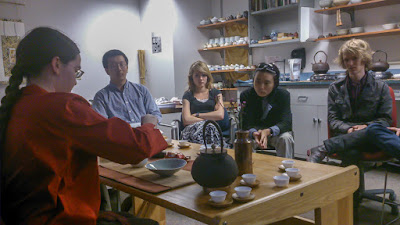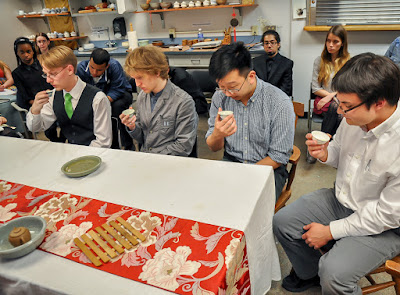Before I write an article about this year's fantastic Chinese ceramics exhibition at the Tea Institute at Penn State, let me show you some pictures from the past so that we can see the evolution and importance of these events.
The Tea Institute had been founded by Jason Cohen in the fall of 2010 and in
spring 2011, it was already organizing its very first event titled "Come Talk Tea With a Taiwanese Teamaster."
Jason was a reader of my blog and managed to persuade me to ask Teaparker if he would be interested in going to the US to teach American students about tea. Teaparker would give lectures that I would translate and I would also share my own experience during our interactive lectures.
Above is a rare picture of what the Tea Instute's tea room looked like in spring 2011 before the bamboo sticks and paper had to be removed from the ceiling (on order of the fire dept).
The main event of this event was a tea serving during the presentation of the 2011 International Taiwan Watercolor exhibition at PSU's Robeson Gallery.
After a couple of days of training, this is what the student's chaxi looked like. We had been able to make them switch from clay teapots to porcelain gaiwan in order to better taste the true flavors of the tea.
Above is my Chaxi. It tries to connect Taiwan's watercolors and tea on a more aesthetic level.
Things were very different in 2011: Jason was wearing a formal suit and tie for his trademark speech! I think Patrick P. once said to me: "Life is like a Jason Cohen speech. You know when it starts, but you never know how it will finish!"
Teaparker's Chaxi featured an ancient Dehua teapot, a Ming dynasty qinghua jar, Qing dynasty chatuo and modern Dehua cups. His brilliant Chaxi brought the connections between art and tea to a new level.
Back in the tea room of the Institute, the classes focused on 2 subjects: Oolong tea tasting.
and Chaxi compositions.
Then came the last brew of a tea that made everybody speechless and happy: a brick of shu puerh 7638. A new ritual was born with this tea. The Tea Institute members brew it every semester as they accept the new members who have passed the test.
The taste of this tea must have impressed the Tea Institute a lot, because it invited Tea Parker and me for a
Pu'er Tea Exhibition in April 2013!
From a general tea talk, the 4 days events are now focused on a single tea family that is very little know in the West: Yunnan puerh, which is part of the hei cha, black (fermented) tea family.
The Tea Institute is a pioneer in the study of tea on American campuses. We've heard of no similar group or association in any Western university. Being a pioneer means taking a lot of risks and sometimes failing. The outdoor tea scheduled on a chilly mid April morning is probably one of the rare fails we experienced.
We were able to get the water to boil and brew tea (after a good hour in the Pennsylvanian wind), but the tiny cups cooled down too soon and didn't make us feel warm. But we felt happy nevertheless, because this was a gathering of people dedicated to a same passion for tea. The Tea Institute learned that mistakes are part of the tea learning process and never scheduled another tea brewing outdoors in April at State College!
And from the above Chaxi, we can see that the students at the Tea Institute are smart and quick learners! That's what makes teaching them so gratifying...
The best way to learn tea is not through long theoretical classes, but by mixing tea knowledge and top grade leaves. Here, above, Jason is slowly opening a brick of an original 1975 '7562' brick! His kind and wonderful parents are standing next to him as they have come all the way from Florida to all our events! (Thanks so much for your support).
We brewed it in a zhuni shuiping teapot and everybody who had this tea still remembers it today! What a powerful, clean and refined Chaqi!
But even though this event was about puerh, Teaparker made the students smell and taste how different cups, teapots... had an impact on the flavors of the tea! And very often the differences are so obvious that almost everybody can smell them!
There's so much one can learn about tea...
...which is why the Tea Institute invited us again in late
April 2014 for a Regional Tea Ceremony Exhibition centered on Chaozhou Gongfucha. This Qing dynasty Chinese tea ceremony practiced in the Chaozhou/Chaoshan area is the ancestor of today's gongfu tea brewing.
We can see from this poster that the subjects of the 4 day event are getting very specific. The students at the Tea Institute don't rehash the past, but dig deeper and deeper.
The right time had come to go back in time with this subject and the tea wares Tea Parker and I brought to Penn State.
This tea set is composed of a white Nifenglu, a zhuni chuanxin diao (the kettle), a zhuni teapot and 3 qinghua porcelain Ruoshen cup. These are the main accessories, considered treasures, for the Chaozhou gongfucha.
This set would have its place in a museum. That's why Tea Parker introduced each accessory during an event at Penn State's Palmer Museum:
Each item is exquisite. The pewter chatuo with petals like waves, the pewter Jianshui with its ancient coin design, the lacquered tray with a dragon painted on it, the tiny but efficient bamboo fan...
Before we transferred this set to the Tea Institute, we had the students practice Gongfucha brewing with less precious modern wares!
They practiced tirelessly day and night, literally!
We also got to taste some amazing Wuyi Yancha teas that left us quite amazed during this event. Wuyi teas were the preferred teas for Chaozhou gongfucha in the early days. It's because they were already so expensive back then that the teapots and cups tended to be very small.
The attendance of the events was growing and we were honored to have M. and Ms. Koike among us. This Japanese couple living in NYC is also very knowledgeable and passionate about tea. They were very touched to see that a new generation of students giving a "renaissance", a new birth, to tea brewing by going back to the roots of tea. This is the best and fastest way to learn.
In 2015, we were back at Penn State for the Yixing Teapot Exhibition. Since we had already taught Oolongs, Puerhs and the Chaozhou Gongfucha brewing, the Tea Institute chose an even more precise subject: Yixing teapots.
We started with the fundamentals: the
various clays. This was a pretty unique opportunity to see and touch the actual stones that are used to make real Yixing teapots. And what is very interesting is that the Penn State students were able to do chemical analysis of these clays in the laboratories of the university. This means that our teachings start to bear some new knowledge!
The fun part of such studies is that they are not purely intellectual. The ultimate goal of tea is enjoyment. And the more you understand it, the better you are able to brew your tea!
This pictures shows that the attendance continued to rise. Everyone wanted a cup of aged Oolong from Da Yu Ling brewed in an antique duanni Ju Lun Zhu!
Stillness and calm are necessary to feel the tiny differences in flavors from one brew to an other.
There's no rush. Good tea in a good teapot will feel more intense if it's allowed to be brewed slowly.
I apologize for the length of this article, but I think it's important to remember all these past events before discussing this year's. Students graduate in the span of 4 years and today's students were not there for the first 2 exhibitions. Therefore, it's important to point out that this year's event builds on the experience accumulated since 2011. Nevertheless, even I was amazed by the level of expertise reached by the students at the Tea Institute this year. Jason, Ryan, Jeff and Sam you have done a very good job!












































































